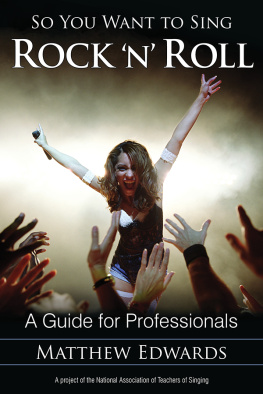108 Strategies of Vocal Improvisation
Over the years, the many groups Ive worked with have inspired me to develop strategies for improvising with the voice and to expand the practice of the Yoga of the Voice. The following list offers some of these strategies. Use them as guidance and let them be a springboard for your creative imagination.
PRELIMINARY PRACTICES
Always begin your practice with awareness of posture. Stand or sit with your weight comfortably balanced on the four corners of your feet, shoulders relaxed, hands open and empty, chin parallel to the floor, and eyes soft.
Breath
Select at least three practices for connecting with breath to begin your practice.
1..
2. In and Out Breathing in Three Parts: Inhale slowly and deeply, hold for a count of five, exhale long.
3..
4. Neck Circles: Holding the breath in the belly, very slowly rotate the neck in a complete circle five times clockwise and five times counterclockwise. Keep your eyes open. At the end, exhale upward toward the crown while lifting your arms overhead (optional). Lower your arms and rest in fresh awareness.
5..
6. Inner Fire: With relaxed shoulders, bend at the waist with your hands on your belly or on your knees. Inhale and exhale rapidly through your nose five times. Keep your eyes open and rest in fresh awareness after the practice.
7. Blowing: Softly, steadily, and slowly blow. Try different lip openings with each new breath.
8..
Consciousness: Sound Meditations
These sound meditations engage our capacity for deep listening and allow the mind to become spacious and clear. These practices are all inspired by my mentor and friend, Pauline Oliveros. (See the resources section to learn where to find more sonic meditations from Pauline.)
9. Breath as Sound: Observe your own breathing, gradually allowing it to become audible. Play with the many sounds of the breath.
10. Deep Listening: Focus on sounds near and far and on the silence between each layer of sound. (See .)
11. Telepathic Resonance: In a dyad or a group, imagine the sound that another person may be listening to. Using your voice and/or your body, make audible the sound that you imagine.
12. Phonetic Awareness: Dissect your name, vocally exploring the sound of each letter and each syllable. Let those sounds make music.
13. Silent Recitation of a Mantra: Chose a mantra or any meaningful phrase, listen to the vibration of it, and recite it silently. (See .)
14. Listening to Your Lover: Imagine your beloved calling you on the phone. Listen inwardly to the texture of his or her voice and use your voice to make the quality of tone you are hearing audible.
Warm-Ups: Activating the Body of the Voice
These practices are great for waking up the voice and body on the espressivo path.
15..
16. Calls, Cries, and Clamors: This is a great practice to project the power of your voice. Calls are aimed at potential listeners, especially a divine listener, and they can take the form of a prayer or supplication. Cries can express sadness or astonishment, and they can become a clamor when made by a group. Wail, exult, moan, go wildbut dont strain your instrument.
17. High-Pitched One-Sound Invocation: Call in a deity or a quality you desire using only one note or type of sound. Listen to track 30: High-Pitched One-Sound Invocation.
18. Humming: Hum softly with closed lips to produce a long and relaxed sound whenever you feel like restarting your paractice or reconnecting with the here and now.
19. Mumming: This is like humming, but you use the syllable mum repeated on a monotone. Feel how the sound resonates in the forehead and along the entire spine.
20. Scanning: See the .
21. Bullroarer: See the Recharging the Brain practice in , page 30.
22. Animal Calls: Play with all varieties of animal calls, both soft and loud.
23. Kecak Voices: Imitate the voices (and movement) of the Balinese monkey chant. (You can easily find videos that demonstrate the monkey chant on the Internet.)
24. Inuit Games: Imitate the breathy sound of Inuit throat singing, with audible inhalations. (You can search the Internet to find video demonstrations of Inuit throat singing.)
25. Cauldron Warming: Using a low voice, stir up the sound of a cauldron in your belly.
26. Recitation/Monotone Voices with a Pulse: Imagine you are a monk (or many monks) chanting monotonously over a drum beat.
27. Sopro: See .
28. Motorcycle Mouth: While blowing through loose lips, go up and down the scale like a motorbike revving its engine. Listen to track 31: Motorcycle Mouth.
29. Bubble and Shake: With loose lips, create bubbling sounds while you shake your head.
30. Energetic Ha Breath: Imagining a marching band, move your arms energetically up and down with each exhalation on ha.
31. Inhaling with Sound: Apply the sounds of your inhalation to create a short repetitive pattern (ostinato). Remember to exhale as welland keep your eyes open. Take refreshing breaths in between.
SONIC YOGIC PRACTICES
The following are practices that come from ancient yogic traditions.
Nada Yoga: Vibration, Sound, Consciousness
32..
33..
34. The Music of Your Heart: Warm up your hands by rubbing them together. Then place them on your chest and softly tap the beat of your heart.
35..
36. Unbroken Sound: See . Listen to audio track 10.
37. Prayer in Dhrupad (Ananda Hari Om): See . Listen to audio track 11.
Shabda Yoga: Sacred Words, Seed Syllables, Mantras
38. Brahm, the Creator: See . Listen to audio track 12.
39. Bija Syllables: See . Listen to audio track 13.
40. Elemental Seed Sounds: See . Listen to audio track 16.
41. Mantra (Om Sree Amma Narayani Namastute): See . Listen to audio track 22.
Bhakti Yoga: Chants of Devotion
42. Chanting the Names: Call the name of deities of any tradition as an invocation.
43. Chanting to the Mother (Jaya Ma): Repetitively chant these words in a slow kirtan style.
44. Chant of Dedication (Twameva Mata): See . Listen to audio track 25.
Tantra Yoga: Chants of Transformation
45. Chanting Ah: Focus on the heart chakra and imagine rainbow lights radiating from the heart.
46. Tara Mantra (Om Tare Tutare Ture Swaha): See Invocation Practices in . Listen to audio track 17.
47. Tibetan Mantra (Om Mani Padme Hum): Bringing the vibration of compassion to your heart, repeat this mantra as many times as possible. See . Listen to audio track 21.
48. Medicine Buddha Mantra (Om Ma Hum): Bringing the vibration of healing to your heart, repeat this mantra as many times as possible, coordinating breath with sound and sound with breath. See .
TUNING THE VOICE
Tuning the voice is an essential part of a successful music practice. Try to incorporate at least one of these exercises into your routine.
49. Sargam (Sa Re Ga Ma Pa Dha Ni Sa): Sing up and down the sargam scale, slowly singing each note. Focus on the approach to each note, neighboring notes, microtones, and intervals. Slow is always better. See .
50. Sargam Circles: Departing from each note, slide microtonally to the lower octave and return to the note you started from. As you circle with your voice, draw circles with your hand to direct the sound.
51. Singing Intervals with a Drone: With a drone accompaniment of any kind, sing any two-note intervals using the sargam syllables or just the syllable ah.
52. Sounding the Space in Between: Listening deeply, slowly explore the space between any two notes using microtonal bending tones.









